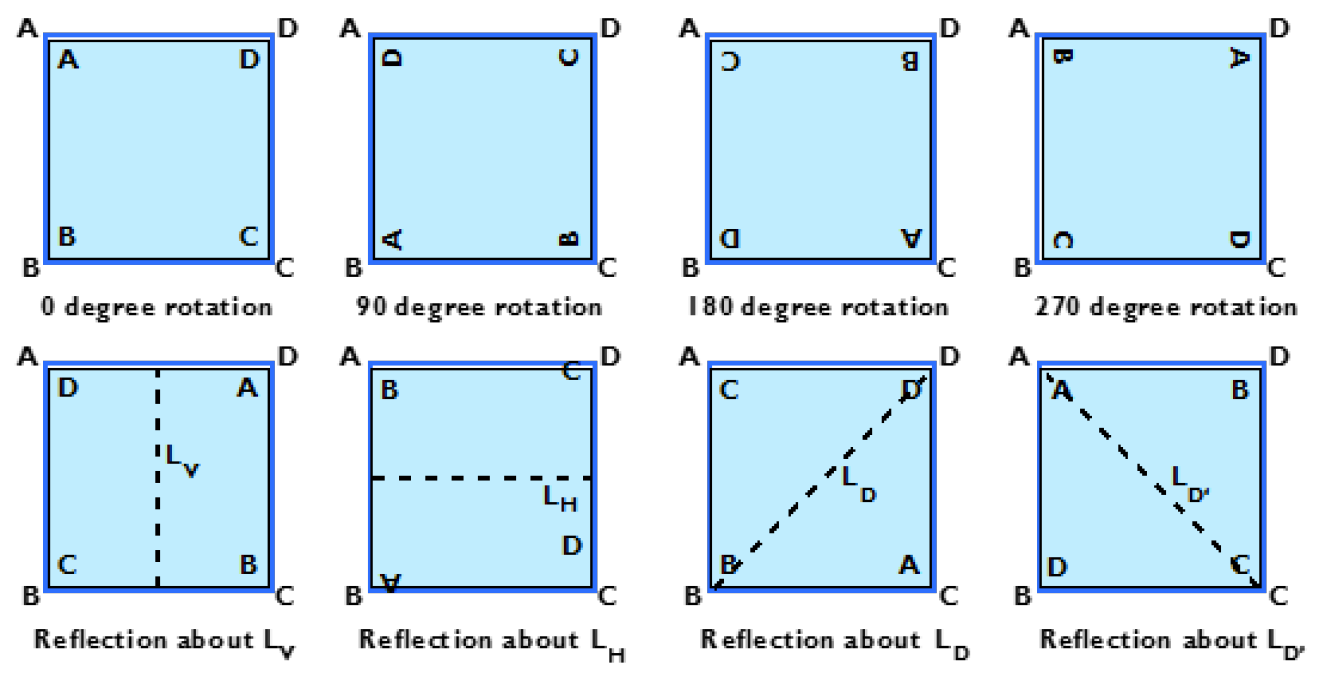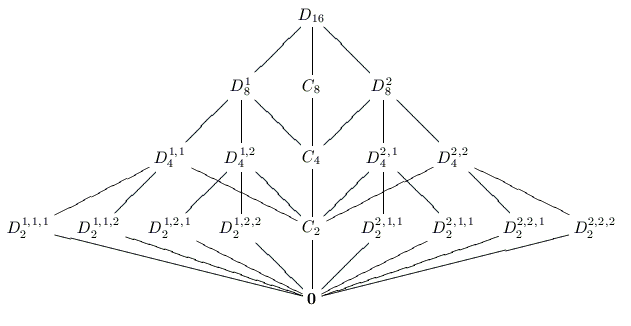I’m back! It’s been a while since I’ve been on this site because I’ve found myself under some financial trouble and I’ve been stressed BUT I wanted to take this opportunity to talk about something I love dearly: dihedral groups!
Consider the symmetries of a square:

We can see that there are 4 reflections and 3 rotations, as well as the act of doing nothing at all. Together, we have 8 total symmetries, and in fact, these are all of the possible symmetries. What this means is that if we do one of these symmetric moves and then do another one, we will have not changed the square, and therefore doing these two moves is the same as doing just one of the 8 symmetries on its own. For example, doing a 90 degree rotation followed by a 180 degree rotation is the same as doing a 270 degree rotation. Also, doing a 90 degree rotation followed by a reflection across the vertical axis is the same as doing a reflection across a diagonal axis.
So in other words, we can define a function that takes two symmetries of a square as input and which outputs another symmetry. Since standard multiplication is a function taking two numbers and outputting another number, it makes sense to borrow the notation of multiplication for this function. Our symmetry function satisfies a few useful properties:
- Closure: As explained above, for any two symmetries, the function will spit out another symmetry
- Identity: There is a symmetry (namely, the “do nothing” symmetry) such that when it is input into the function with another symmetry, the function will always simply output the other symmetry
- Associativity: For any symmetries a, b, and c, (ab)c = a(bc)
- Inverses: For every symmetry, there is a symmetry that undoes it. For example, rotating a square by 270 degrees undoes rotating it by 90 degrees, and doing a reflection a second time after doing it once undoes the first reflection
These 4 properties are so important that any set of objects with a function defined on it that satisfies all of these properties has a special name: they’re called groups and they’re really freaking awesome. The symmetries of a square as a group is called D~8~, since there are 8 total symmetries. Sometimes you might see it called D~4~, since squares have 4 sides, but I think this convention is a bit silly. In the same way, D~6~ is the symmetries of an equilateral triangle, D~10~ is the symmetries of a regular pentagon, and so forth. In general, D~2n~ is the symmetries of a regular n-gon.
Now, one interesting thing is that groups can contain each other. For example, consider an octagon. Since there are squares hidden within the points of octagons, if we pick a square we can see that all of the symmetries of that square are present in the symmetries of of the octagon, so it is possible to throw out all of the other symmetries. What we would be left with is just the symmetries of a square. What this means is that D~8~ is contained in D~16~. You can play similar games to show that there are lots of groups contained inside the dihedral groups.
The last thing I want to talk about regarding these things are their subgroup lattices. Oftentimes mathematicians want to picture the internal structure of a group. One of the ways they might do this is by writing down all of the subgroups of a group they’re studying onto a piece of paper, and then connecting any two with a line if one of them is a subgroup of the other that doesn’t have a subgroup between them. The resulting picture is called a subgroup lattice, and I’ve left some dihedral group lattices below because I think they’re pretty.
two cute dihedral subgroup lattices holding hands and cuddling


Anyway this has been gushposting with your host, yewler. Maybe next mega I might talk about more specific details that make these things cool.
Now you may commence in the posting
Join our public Matrix server!
https://matrix.to//#/#tracha-space:transfem.dev
https://rentry.co/tracha#tracha-rooms
As a reminder, please do not discuss current struggle sessions in the mega. We want this to be a little oasis for all of us and the best way to do that is not to feed into existing conflict on the site.
Also, be sure to properly give content warnings and put sensitive subjects behind proper spoiler tags. It's for the mental health of not just your comrades, but yourself as well.
Here is a screenshot of where to find the spoiler button.


Measurements and brainworms
Every time I measure myself or get measured I somehow get closer to having an hourglass figure despite doing literally nothing. My waist keep getting thinner and my chest and hips keep getting wider. I'm genuinely even close to my hips being as wide as my shoulders.My brain can't keep up or cope with it. I still feel like someone who wears men's medium/large and is bigger than the women around me despite the fact that I currently wear women's smalls and, beyond height, most women I know have bigger sizes than me. I even know that, when I first measured myself pre-E, that I was actually on par with cis women's measurements (based on the dress I was ordering) with the one exception being my waist which has since gotten smaller such that everything is on par now except occasionally height and shoulder width depending on the piece. So I recognise that I was actually more feminine in build in the first place than I thought I was, and I recognise that I'm incredibly lucky to have this sort of body. And I'm really grateful about that, I love it and I've loved watching it sculpt itself with estrogen.
But it is also existentially terrifying to consider when it shows just how much my body has changed in the 1.5 years since I started E and got kicked out. My waist getting thinner? That's because I literally ate nothing more than one muffin a day (at best) for a whole month immediately after I was kicked, and while I've been eating better I'm still not eating as well as I used to. My boobs and hips getting bigger? Typical estrogen effects that make me happy, but it's also pushing me into having a hourglass-adjacent body shape that is, for trans women, very atypical and feels almost alien compared to what I expected my body to become. I'll reiterate that I'm incredibly happy with all of these changes. But I'd be lying if I didn't say that whenever I get a concrete number to think about it scares me a little. It's always a reminder of where I was a year and a half ago and how my self-image doesn't align with my actual self at times, it's always a reminder of how quick a body can drastically change, and it's always a reminder that, maybe, a lot of the things I was dysphoric over were never quite so bad as they used to feel to me.
To use a term I loathe, being faced with these concrete numbers make me feel like I've been a "bdd passoid." I despise that term and how people use it to just insult anyone they consider prettier than them, while being dismissive of whatever dysphoria the person in question has. But it almost feels like it fits me, when I'm given these exact measurements that tell me not only is my body close to cisnormative patriarchal beauty standards in ways unattainable for other people, but it's been that way for maybe longer than I thought.
I've always had a very visual relationship with my dysphoria. It feels like, if I can't see the thing I'm dysphoric about in the moment, then it stops being present in my head. A good example is body hair. I often don't shave as often when it's winter and I'm wearing pants or tights since I can't see, and thereby feel bad about, my body hair. I'd prefer to always be clean shaven, of course. But there's a point where the cost-benefit ratio of shaving my body loses out and it's when I will be actively seeing the dysphoria-inducing thing in question. So this makes the possibility of being a "bdd passoid" feel stronger, after all, BDD is more obsessed with a false perception than anything actual. Maybe my dysphoria was always just that.
But that line of thought ends there, because I am genuinely very happy with my appearance now, in a way where BDD wouldn't seem to apply to me as well. And I mean, of course. "bdd passoids" are usually people who do worry about certain features and the term is just used as a cudgel to be shitty and dismissive of their hurt, to suggest that one's own hurt is more real and therefore valid unlike the passoid's. It's a cruel term like everything else that's come from /tttt/ and its adjacent spaces.
But in my case specifically, it matters that the thing that provokes this feeling is getting concrete measurements. I've always used body measurements as a way to actually track how femme I am, trying to chase a ridiculous cisnormative beauty standard because it's the thing that I thought would bring me some joy. And now that I've gotten quite close to it... It has. And so much of my dysphoria around these things is gone, and goes away every time I do it again. But certain things, my smallness in particular, haven't sunk in yet.
I don't really think my obsession with measurements has been healthy at all. I mean, obviously right? I became so fixated on them because it felt like a calculable way to determine what I'd need to magically pass. The same sort of toxic relationship with my body that spaces like /tttt/ promote, even if I never went there. I've never been quite so bad that I'd measure myself constantly; I only do it when necessary for clothing purchases. But nonetheless it has often been a huge source of both euphoria and dysphoria. Now that I've reached the "good" measurements, it always provokes euphoria. But it also always reminds me that I used to have a body that some would consider already lucky for a trans woman. So why wasn't I satisfied with it? Well, I don't think it was the right body for me. Why should I fixate on if I'm allowed to have felt dysphoric about it. I felt dysphoric regardless, wishing that away won't change anything. And now that I feel euphoric about my body more often than not, why should I believe that it's me being a "bdd passoid" rather than simply a dysphoria about something that just wasn't right for me? Why shouldn't I be allowed to feel this tangled mess of positive and negative emotions when I get a measurement and recognise how far I've come in this tangled mess of a life I've lived? I think that's where I'm at, now. It's a messy feeling that I get, and it's probably not the healthiest thing to feel when being measured. But I also don't think it's so negative as it could be. I'm okay with who I am, both body and mind, even if it took some time to get here.
i don't have much to say except I can relate to a lot of this.
spoiler
I'm very grateful for the way my body is, but I still do struggle sometimes with dysphoria about certain things. I don't typically talk about things like measurements since when I was much younger I was in a situation for some reason where a friend and I were measuring each other and she got mad that I was "better" than her.